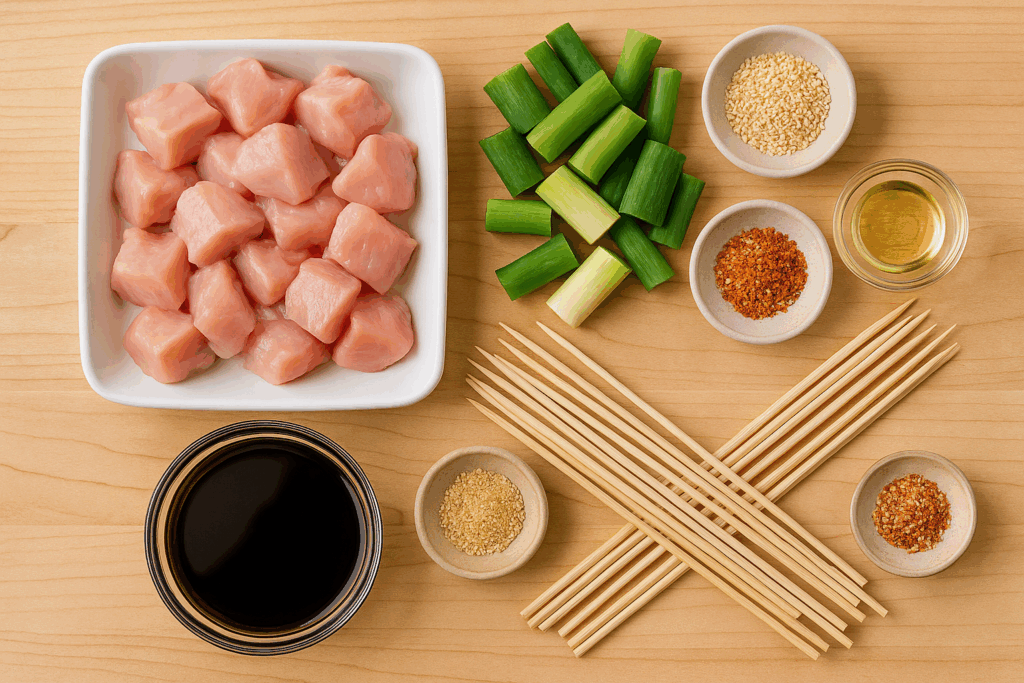Yakitori, a staple of Japanese cuisine, is a simple yet deeply flavorful dish that consists of skewered and grilled chicken, often seasoned with a sweet-savory tare sauce. The name itself translates to “grilled chicken,” but this dish is more than just a method of cooking; it embodies the spirit of Japanese culinary artistry. Traditionally cooked over binchotan charcoal, yakitori is known for its smoky, caramelized exterior and juicy interior, making it a favorite at izakayas (Japanese pubs) and street stalls alike. Its preparation may seem straightforward, but achieving the perfect balance of tenderness, char, and sauce requires skill and precision.
In Japan, yakitori is more than just a dish—it is an experience. Found in bustling city streets and quiet countryside towns, yakitori stalls serve as gathering places where people come together over skewers of grilled meat, cold drinks, and good conversation. Unlike many Western barbecue traditions that involve large cuts of meat, yakitori is often cooked in bite-sized portions, making it ideal for casual eating. The communal aspect of sharing plates of yakitori fosters a sense of togetherness, which is deeply ingrained in Japanese culture. Whether enjoyed in an intimate setting or at a lively festival, yakitori represents the joy of simple, delicious food shared with others.
One of the key reasons yakitori remains so beloved is its versatility. While chicken thighs and scallions are among the most common ingredients, various cuts of chicken—including wings, liver, and skin—are also used, each bringing a unique texture and taste. The tare sauce, a blend of mirin, sake, soy sauce, and sugar, is essential to the dish, providing a rich umami depth that enhances the natural flavors of the grilled chicken. Some variations even include a salt-based seasoning instead of tare, highlighting the smoky, charred flavor of the meat. This adaptability allows yakitori to cater to different palates, making it an enduring favorite among locals and visitors alike.
The cooking process of yakitori is just as important as the ingredients. Using a grill, ideally with high-quality Japanese charcoal, ensures an even heat that cooks the chicken to perfection while imparting a subtle smoky aroma. The skewers are turned frequently, with each rotation adding a delicate char to the meat, and they are brushed repeatedly with the tare sauce to create a glossy, flavorful coating. The final result is a beautifully balanced dish—sweet, savory, smoky, and slightly crispy on the outside, yet tender and juicy on the inside. Whether grilled at home or enjoyed at a traditional yakitori-ya, the technique behind yakitori remains a testament to Japanese culinary craftsmanship.
Yakitori continues to be a symbol of Japan’s appreciation for simple yet refined flavors. It serves as a bridge between tradition and modernity, maintaining its roots in Japanese history while remaining a popular street food choice today. Beyond being a dish, yakitori is a cultural experience, embodying the harmony of flavors, social connections, and meticulous cooking techniques that define Japanese cuisine. For those looking to recreate this authentic experience at home, the following yakitori recipe offers a delicious introduction to this timeless classic.
Yakitori Recipe
Ingredients

Tare Sauce:
- 1 tablespoon granulated sugar
- 1/4 cup mirin
- 1/4 cup sake
- 1/2 cup reduced-sodium soy sauce
Skewers:
- 1 bunch scallions (white and light green parts, cut into 1″ pieces)
- 1 pound boneless, skinless chicken thighs (cut into 1″ pieces)
- 10 to 12 bamboo skewers (soaked in water for 30 minutes)
For Grilling:
- Vegetable oil (for grill)
For Serving (Optional):
- Shichimi togarashi
- Toasted sesame seeds
Directions
- Prepare the Skewers:
- Soak bamboo skewers in water for at least 30 minutes to prevent burning during grilling.
- Make the Tare Sauce:
- In a small pot over medium-high heat, bring soy sauce, mirin, sake, and sugar to a boil.
- Reduce heat to low and let simmer for 5 to 7 minutes until slightly thickened.
- Remove from heat and allow to cool to room temperature. Reserve 1/4 cup of the sauce in a small bowl for basting.
- Assemble the Skewers:
- Fold each piece of chicken in half and thread onto a skewer.
- Alternate with scallion pieces until each skewer has 4 pieces of chicken and 3 pieces of scallion.
- Grill the Yakitori:
- Preheat a grill to medium-high heat (about 5 minutes).
- Lightly brush the grates with vegetable oil.
- Grill the skewers, turning occasionally, for about 4 minutes.
- Begin basting with the reserved tare sauce after each turn and continue grilling until the internal temperature of the chicken reaches 165°F, about 4 to 5 minutes more.
- Finish and Serve:
- Arrange the skewers on a platter.
- Using a clean brush, baste the skewers with additional sauce.
- Sprinkle with toasted sesame seeds and shichimi togarashi if desired.
- Serve immediately and enjoy!
